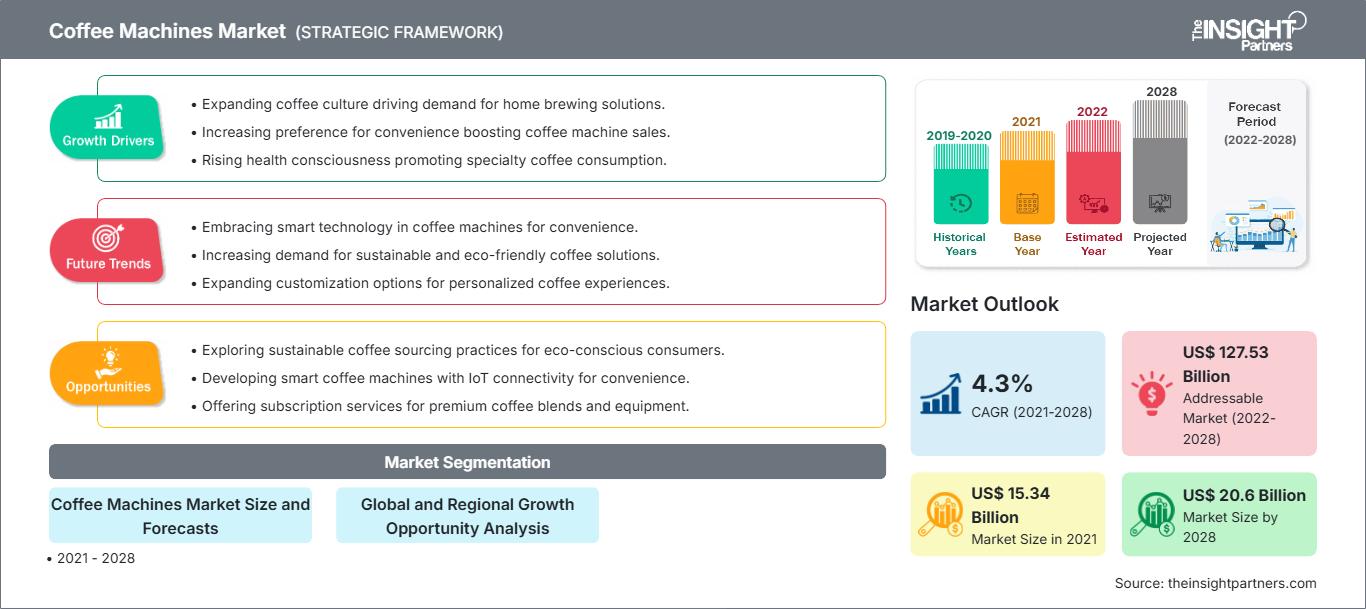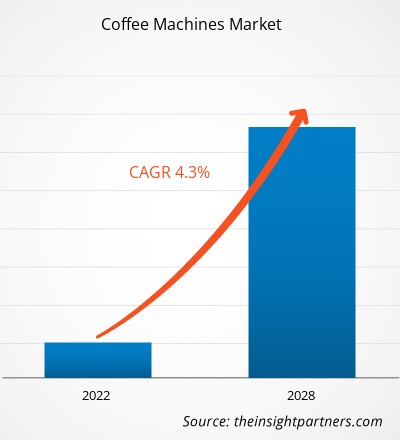[Informe de investigación] El tamaño del mercado de las máquinas de café se valoró en US$ 15.340,75 millones en 2021 y se proyecta que alcance los US$ 20.596,79 millones para 2028; se espera que crezca a una CAGR del 4,3% de 2021 a 2028.
Perspectivas del mercado y opinión de los analistas:
Una cafetera es un dispositivo que se utiliza para preparar café. Existen varios tipos de cafeteras, como la prensa francesa, la cafetera expreso, la cafetera de filtro, la cafetera de cápsulas y la cafetera monodosis, entre otras. Cada máquina funciona con un mecanismo diferente. Por ejemplo, en una cafetera de filtro, el agua gotea automáticamente en un tubo calefactor y se vierte sobre el café molido que pasa por un filtro. Sin embargo, en una cafetera de cápsulas y monodosis, el café se envasa en una cápsula de plástico o aluminio, dentro de un pequeño recipiente que se introduce en la cafetera y se prepara. Existe una creciente demanda de cafeteras tanto en el sector empresarial como en el institucional. Este factor impulsa significativamente el mercado global de cafeteras.
Factores impulsores del crecimiento y desafíos:
En los últimos años, el estilo de vida ha cambiado drásticamente debido a los horarios laborales ajetreados y las jornadas laborales extendidas. Debido a este ritmo de vida acelerado, las personas optan cada vez más por alimentos y bebidas precocinados. En el sector empresarial, las personas están continuamente expuestas al estrés laboral, por lo que buscan tiempo libre para compartir con sus colegas y amigos. El café es una bebida versátil y ampliamente consumida gracias a su delicioso sabor y aroma. Además, su contenido de cafeína ayuda a mejorar el estado de ánimo y a generar motivación. Este factor está impulsando significativamente la industria del café a nivel mundial. Las máquinas de café permiten preparar café al instante, razón por la cual existe una gran demanda de máquinas de café en el sector empresarial. Este factor está impulsando significativamente el mercado de las máquinas de café. Sin embargo, a medida que aumenta la conciencia sobre la alta adicción del café, se lo está reemplazando por otras bebidas como jugos de frutas naturales, té de burbujas, aguas con gas, etc. Asimismo, la creciente conciencia sobre las consecuencias negativas para la salud del alto consumo de cafeína también está frenando la demanda de café entre las personas. Se espera que estos factores afecten negativamente el consumo de café, obstaculizando la demanda de máquinas de café durante el período de pronóstico.
Obtendrá personalización en cualquier informe, sin cargo, incluidas partes de este informe o análisis a nivel de país, paquete de datos de Excel, así como también grandes ofertas y descuentos para empresas emergentes y universidades.
Mercado de máquinas de café: Perspectivas estratégicas

- Obtenga las principales tendencias clave del mercado de este informe.Esta muestra GRATUITA incluirá análisis de datos, desde tendencias del mercado hasta estimaciones y pronósticos.
Segmentación y alcance del informe
El mercado global de cafeteras está segmentado por tipo, categoría, usuario final y ubicación geográfica. Según el tipo, el mercado se divide en cafeteras de filtro, cafeteras espresso, cafeteras de cápsulas y monodosis, entre otras. Según la categoría, el mercado se clasifica en manuales, automáticas y semiautomáticas. Según el usuario final, el mercado se segmenta en residencial y no residencial. El mercado de cafeteras, según la ubicación geográfica, se segmenta en Norteamérica (EE. UU., Canadá y México), Europa (Alemania, Francia, Italia, Reino Unido, Rusia y resto de Europa), Asia Pacífico (Australia, China, Japón, India, Corea del Sur y resto de Asia Pacífico), Oriente Medio y África (Sudáfrica, Arabia Saudita, Emiratos Árabes Unidos y resto de Oriente Medio y África), y Sudamérica y Centroamérica (Brasil, Argentina y resto de Sudamérica y Centroamérica).UAE, and Rest of Middle East & Africa), and South & Central America (Brazil, Argentina, and Rest of South & Central America)
Análisis segmentario:
Según el usuario final, el mercado de las cafeteras se divide en residencial y comercial. El segmento residencial tuvo una participación significativa en el mercado y se espera que registre un crecimiento significativo durante el período de pronóstico. La creciente adopción del café y el creciente interés en diferentes tipos de tueste y preparación de café están impulsando la demanda de cafeteras en el sector residencial. Además, debido al brote de COVID-19, se ordenó a las personas quedarse en casa y todos los establecimientos de restauración permanecieron cerrados. Esto disparó la demanda de cafeteras en los hogares, especialmente en los países desarrollados. Todos estos factores están impulsando potencialmente el mercado de las cafeteras a nivel mundial.
Análisis regional:
Según la geografía, el mercado de las cafeteras se divide en cinco regiones clave: Norteamérica, Europa, Asia Pacífico, Sudamérica y Centroamérica, y Oriente Medio y África. El mercado mundial de cafeteras estuvo dominado por Europa, que representó 4.951,77 millones de dólares en 2022. Norteamérica es el segundo mayor contribuyente, con más del 20% del mercado mundial. Se espera que Asia Pacífico registre un crecimiento considerable con una CAGR superior al 5% durante el período previsto. El aumento del consumo diario de café en los países norteamericanos, especialmente en Estados Unidos, está impulsando la demanda de cafeteras. Según la Asociación Nacional del Café (NCA), el 62% de los estadounidenses consume café a diario. Además, la creciente tendencia del consumo para llevar, debido al ritmo de vida acelerado, también está impulsando la demanda de cafeteras en el sector no residencial de Norteamérica.
Desarrollos de la industria y oportunidades futuras
A continuación se enumeran varias iniciativas tomadas por los actores clave que operan en el mercado de máquinas de café:
- En marzo de 2023, De'Longhi, uno de los principales fabricantes de máquinas de café, lanzó Truerew, una máquina de café de goteo totalmente automática que elimina la necesidad de medir el café y cualquier conjetura, lo que permite a los consumidores disfrutar de una experiencia de café recién molido superior.
- En octubre de 2020, Nespresso Professional lanzó nuevas funciones sin contacto en sus máquinas de café Nespresso Momento que brindarán mayor seguridad en los lugares de trabajo tras la pandemia de COVID-19.
- En marzo de 2022, Breville Group, fabricante australiano de equipos de café para el hogar, anunció la adquisición de Lelit, empresa italiana de equipos de café espresso para consumidores profesionales. La gama de máquinas de café espresso para el hogar de Lelit complementa la oferta existente de Breville Group. Esta adquisición permitirá a la empresa llegar a un amplio público, ampliando su alcance y aumentando sus ingresos.
- En marzo de 2021, De'Longhi adquirió el 60% restante de Eversys, fabricante suizo de máquinas de café. La empresa cuenta con una cartera de máquinas de café espresso totalmente automáticas. La adquisición permitirá a De'Longhi ampliar su línea de productos y atender a un gran número de consumidores en diferentes regiones.
Impacto del Covid-19:
La pandemia de COVID-19 afectó a casi todas las industrias en varios países. Los confinamientos, las restricciones de viaje y el cierre de negocios en América del Norte, Europa, Asia Pacífico (APAC), América del Sur y Central (SAM) y Oriente Medio y África (MEA) obstaculizaron el crecimiento de varias industrias, incluida la industria de bienes de consumo. El cierre de las unidades de fabricación perturbó las cadenas de suministro globales, las actividades de fabricación, los plazos de entrega y las ventas de productos esenciales y no esenciales. Varias empresas experimentaron retrasos en las entregas de productos y una caída en las ventas de sus productos en 2020. Debido a la recesión económica inducida por la pandemia, los consumidores se volvieron más cautelosos y selectivos en sus decisiones de compra. Las compras no esenciales se redujeron significativamente por parte de los consumidores debido a los menores ingresos y las perspectivas de ganancias inciertas, especialmente en las regiones en desarrollo. Muchos fabricantes de máquinas de café enfrentaron una disminución en las ganancias debido a la menor demanda de los consumidores durante la fase inicial de la pandemia. Sin embargo, para finales de 2021, muchos países estaban completamente vacunados y los gobiernos anunciaron la flexibilización de ciertas regulaciones, incluyendo confinamientos y prohibiciones de viaje. La gente comenzó a viajar a diferentes lugares, lo que incrementó la demanda de café en aeropuertos y estaciones de tren, impulsando así la demanda de máquinas de café. Todos estos factores influyeron positivamente en el crecimiento del mercado de máquinas de café en diferentes regiones.
Análisis regional del mercado de máquinas de café
Los analistas de The Insight Partners han explicado detalladamente las tendencias regionales y los factores que influyen en el mercado de máquinas de café durante el período de pronóstico. Esta sección también analiza los segmentos y la geografía del mercado de máquinas de café en América del Norte, Europa, Asia Pacífico, Oriente Medio y África, y América del Sur y Central.
Alcance del informe de mercado de máquinas de café
| Atributo del informe | Detalles |
|---|---|
| Tamaño del mercado en 2021 | US$ 15.34 mil millones |
| Tamaño del mercado en 2028 | US$ 20.6 mil millones |
| CAGR global (2021-2028) | 4,3% |
| Datos históricos | 2019-2020 |
| Período de pronóstico | 2022-2028 |
| Segmentos cubiertos | Tamaño y pronósticos del mercado de máquinas de café
|
| Regiones y países cubiertos | América del norte
|
| Líderes del mercado y perfiles de empresas clave |
|
Densidad de actores del mercado de máquinas de café: comprensión de su impacto en la dinámica empresarial
El mercado de las cafeteras está creciendo rápidamente, impulsado por la creciente demanda del usuario final debido a factores como la evolución de las preferencias de los consumidores, los avances tecnológicos y un mayor conocimiento de los beneficios del producto. A medida que aumenta la demanda, las empresas amplían su oferta, innovan para satisfacer las necesidades de los consumidores y aprovechan las tendencias emergentes, lo que impulsa aún más el crecimiento del mercado.

- Obtenga una descripción general de los principales actores clave del mercado de máquinas de café
Panorama competitivo y empresas clave:
Entre las empresas líderes del mercado global de cafeteras se encuentran Keurig Green Mountain, Inc.; Robert Bosch GmbH; Electrolux AB; illycaffè SpA; Koninklijke Philips NV; Krups GmBH (Groupe SEB); Morphy Richards; Nestlé SA; Panasonic Corporation; LUIGI LAVAZZA SPA; De'Longhi Appliances Srl, entre otras. Estas empresas ofrecen cafeteras de vanguardia con características y técnicas de preparación innovadoras para brindar a los consumidores una experiencia de café superior.
- Análisis histórico (2 años), año base, pronóstico (7 años) con CAGR
- Análisis PEST y FODA
- Tamaño del mercado, valor/volumen: global, regional y nacional
- Industria y panorama competitivo
- Conjunto de datos de Excel
Informes recientes
Informes relacionados
Testimonios
Razón para comprar
- Toma de decisiones informada
- Comprensión de la dinámica del mercado
- Análisis competitivo
- Información sobre clientes
- Pronósticos del mercado
- Mitigación de riesgos
- Planificación estratégica
- Justificación de la inversión
- Identificación de mercados emergentes
- Mejora de las estrategias de marketing
- Impulso de la eficiencia operativa
- Alineación con las tendencias regulatorias




















 Obtenga una muestra gratuita para - Mercado de máquinas de café
Obtenga una muestra gratuita para - Mercado de máquinas de café